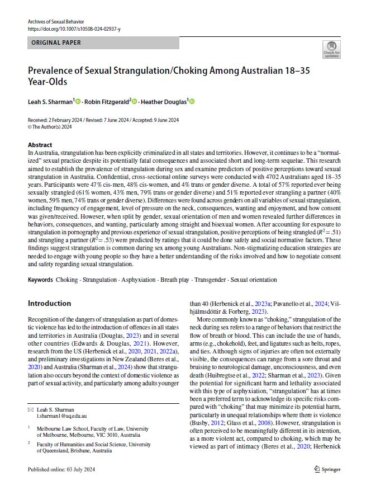Violence
Prevalence of Sexual Strangulation/Choking Among Australian 18–35 Year‐Olds.
Open Access: Yes
Abstract
In Australia, strangulation has been explicitly criminalized in all states and territories. However, it continues to be a “normalized” sexual practice despite its potentially fatal consequences and associated short and long-term sequelae. This research aimed to establish the prevalence of strangulation during sex and examine predictors of positive perceptions toward sexual strangulation in Australia. Confidential, cross-sectional online surveys were conducted with 4702 Australians aged 18–35 years. Participants were 47% cis-men, 48% cis-women, and 4% trans or gender diverse. A total of 57% reported ever being sexually strangled (61% women, 43% men, 79% trans or gender diverse) and 51% reported ever strangling a partner (40% women, 59% men, 74% trans or gender diverse). Differences were found across genders on all variables of sexual strangulation, including frequency of engagement, level of pressure on the neck, consequences, wanting and enjoyment, and how consent was given/received. However, when split by gender, sexual orientation of men and women revealed further differences in behaviors, consequences, and wanting, particularly among straight and bisexual women. After accounting for exposure to strangulation in pornography and previous experience of sexual strangulation, positive perceptions of being strangled (R2 = .51) and strangling a partner (R2 = .53) were predicted by ratings that it could be done safely and social normative factors. These findings suggest strangulation is common during sex among young Australians. Non-stigmatizing education strategies are needed to engage with young people so they have a better understanding of the risks involved and how to negotiate consent and safety regarding sexual strangulation.
Relevance
The paper begins by stating that “Recognition of the dangers of strangulation as part of domestic violence has led to the introduction of offences in all states and territories in Australia…and in several other countries.” Moreover, there is “potential for significant harm and lethality associated with this type of asphyxiation.”
The paper also reiterated findings from other studies, including: Women are “more often strangled and men more likely to be the strangler” and that pornography is “helping to drive” the increase in incidence as well as “young people’s belief that it is a safe practice.” Furthermore, “watching pornography was associated with a higher likelihood of being exposed to depictions of strangulation during sex, which in turn predicted a higher likelihood of strangling sexual partners.” Also, in many instances, sexual strangulation occurs without consent.
The study itself found that:
“Pornography was the most common avenue by which people reported first hearing about choking during sex.”
More than half of the study participants reported being sexually strangled.
“Trans and gender diverse participants were more likely to have ever been choked (78%) followed by women (60.5%), and men (42.8%).
“Participants who were choked more frequently identified that consent was not given beforehand (24.9%) compared to those who had choked partners (15%).”
“Women were more likely to ever have been strangled than men, and men were more likely to have ever strangled partners than women during sex.”
“Our findings reveal that, in Australia, sexual strangulation has become a mainstream sexual behavior that is commonly seen in media such as pornography…It is engaged in by more than half of men, women, and trans and gender diverse people aged 18–35 who have previously had sex. Largely, strangulation during sex is viewed positively and this was predicted by the perception that it can be safe and is an expected and social normative behavior. These perceptions of safety are at odds with the numerous and potentially significant harms that strangulation can cause and worryingly, a large proportion of participants thought prior consent for sexual strangulation was an acceptable form of consent for future choking activities…These results indicate the need for developing strong sexual health education around consent, harms, and normative expectations around sexual strangulation in Australia.”
Citation
Sharman, L.S., Fitzgerald, R. & Douglas, H. (2024). Prevalence of Sexual Strangulation/Choking Among Australian 18–35 Year-Olds. Archives of Sexual Behavior. https://doi.org/10.1007/s10508-024-02937-y

